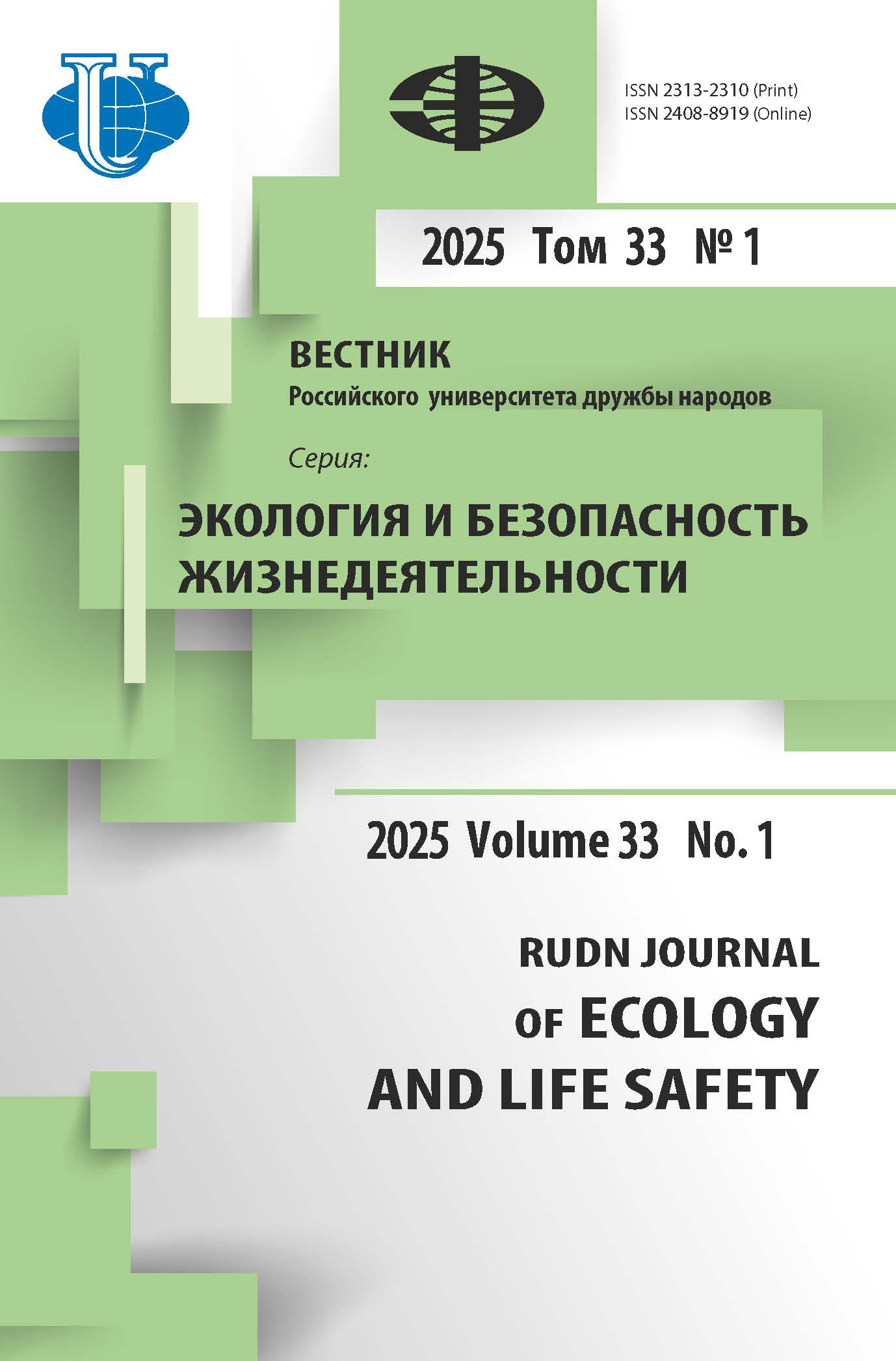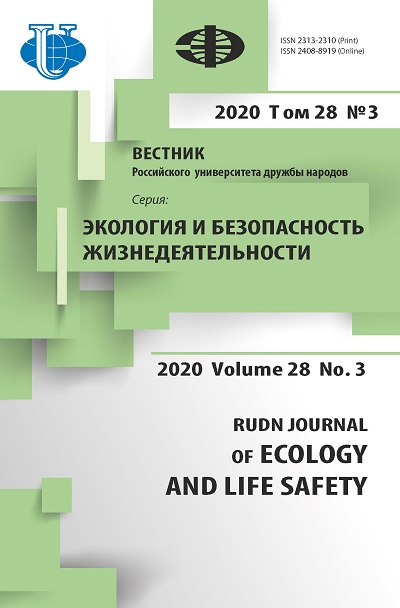Distribution of photosynthetic species in grotto type caves of different regions
- Authors: Mazina S.E.1,2, Popkova A.V.2
-
Affiliations:
- Lomonosov Moscow State University
- Peoples’ Friendship University of Russia (RUDN University)
- Issue: Vol 28, No 3 (2020)
- Pages: 275-284
- Section: Ecology
- URL: https://journals.rudn.ru/ecology/article/view/26415
- DOI: https://doi.org/10.22363/2313-2310-2020-28-3-275-284
Cite item
Full Text
Abstract
The article discusses the ecological significance of the phototrophic communities developing in entrance zone of grotto type caves as ecotones and refugiums. Species intrazonality and the dependence of cave species’ composition on geographic location were considered. The aim of present study was to identify similar caves of different regions based on the species composition of phototrophic communities using own data and data from literature. The empiric basis for investigation was present by phototropic species lists of own studies conducted by standard methods for phototropic species identification, as well as species lists from literature. The most frequently encountered phototrophs were species Chroococcus minutus and Chlorella vulgaris. Their occurrence in all the studied caves was revealed based on the taxonomic analysis. Thus, the intrazonal nature of the flora developed in grotto type caves is partially confirmed. Cluster analysis applying Euclidean distance was used to estimate similarity of the phototrophic communities developed in grotto caves of various genesis. Four clusters were identified: cretaceous caves of the Voronezh region; limestone grottoes of Ukraine and Abkhazia; monastic cells of Moldova and Ukraine; caves of Italy and Hungary. The dependence of the phototrophs biodiversity on the composition of the rocks and the genesis of the cavities was established. The geographical trend of photosynthetic species distribution in the grotto type caves was revealed.
Keywords
About the authors
Svetlana E. Mazina
Lomonosov Moscow State University; Peoples’ Friendship University of Russia (RUDN University)
Author for correspondence.
Email: conophytum@mail.ru
senior research fellow of the Faculty of Chemistry of the Lomonosov Moscow State University; Associate Professor of the Department of Environmental Monitoring and Forecasting of the Ecological Faculty of the Peoples’ Friendship University of Russia (RUDN University).
1 Leninskiye Gory, bldg 3, Moscow, 119991, Russian Federation; 6 Miklukho-Maklaya St, Moscow, 117198, Russian FederationAnna V. Popkova
Peoples’ Friendship University of Russia (RUDN University)
Email: popkova_av@mail.ru
assistant of the Department of Environmental Monitoring and Forecasting of the Ecological Faculty
6 Miklukho-Maklaya St, Moscow, 117198, Russian FederationReferences
- Prous X, Lopes Ferreira R, Jacobi CM. The entrance as a complex ecotone in a Neotropical cave. International Journal of Speleology. 2015;44(2):177-189.
- Hills N, Hose GC, Cantlay AJ, Murray BR. Cave invertebrate assemblages differ between native and exotic leaf litter. Austral Ecology. 2008;33(3):271-277.
- Novak T, Perc M, Lipovsek S, Janžekovič F. Duality of terrestrial subterranean fauna. International Journal of Speleology. 2012;41(2):181-188.
- Kozlova EV, Mazina SE, Pešić V. Biodiversity of phototrophs in illuminated entrance zones of seven caves in Montenegro. Ecologica Montenegrina. 2019;20:24-39.
- Abdullin ShR, Mirkin BM. Syntaxonomy of cyanobacterial-algal cenoses of caves in Russia and some neighboring states. Vegetation of Russia. 2015;27:3-23. (In Russ.)
- Popkova A, Mazina S. Microbiota of Otap Head Cave. Environmental Research, Engineering and Management. 2019;75(3):71-82.
- Ignatov MS, Ignatova EA. Flora mkhov srednei chasti Evropeiskoi Rossii [Flora of mosses of the European part of Russia]. Moscow: KMK Publ.; 2003. (In Russ.)
- Ignatov MS, Ignatova EA. Flora mkhov srednei chasti Evropeiskoi Rossii [Flora of mosses of the European part of Russia]. Moscow: KMK Publ.; 2003. (In Russ.)
- Guiry MD, Guiry GM. AlgaeBase. World-wide electronic publication. Ireland, Galway: National University; 2020. Available from: http//www.algaebase.org (accessed: 20.03.2020).
- Buczkó K, Rajczy M. Contributions to the flora of the Hungarian caves II. Flora of the three caves near Beremend, Hungary. Studia Botanica Hungarica (Antea: Fragmenta Botanica). 1989;21:13-26.
- Vinogradova ON, Mikhailyuk TI. Algal flora of caves and grottoes in the national nature park “Podilsky Tovtry” (Ukraine). Algologia. 2009;19(2):155-171. (In Russ.)
- Cennamo P, Marzano C, Ciniglia C, Pinto G, Cappelletti P, Caputo P, Pollio A. A survey of the algal flora of anthropogenic caves of Campi Flegrei (Naples, Italy) archeological district. Journal of Cave and Karst Studies. 2012;74(3):243-250.
- Sharipova MYu. Algae of karst caves of the Shulgan-Tash nature reserve (South Ural, Russia). Algologia. 2001;11:441-450. (In Russ.)
- Lamprinou V, Pantazidou A, Papadogiannaki G, Radea C, Economou-Amilli A. Cyanobacteria in Leontari Cave. Fottea. 2009;9(1):155-164.
- Martinez A, Asencio AD. Distribution of Cyanobacteria at the Gelada Cave (Spain) by physical parameters. Journal of Cave and Karst Studies. 2010;72(1):11-20.
- Czerwik-Marcinkowska J. Observations on aerophytic cyanobacteria and algae from ten caves in the Ojców national park. Acta Agrobotanica. 2013;66(1):39-52.
- Popović S, Simić GS, Stupar M, Unković N, Jovanović J, Grbić ML. Cyanobacteria, algae and microfungi present in biofilm from Božana Cave (Serbia). International Journal of Speleology. 2015;44:141-149.
- Macedo MF, Miller AZ, Dionísio A, Saiz-Jimenez C. Biodiversity of cyanobacteria and green algae on monuments in the Mediterranean Basin: an overview. Microbiology. 2009;155:3476-3490.
- Selvi B, Altuner Z. Algae of Ballıca Cave (Tokat-Turkey). International Journal of Natural and Engineering Sciences. 2007;1(3):99-103.
- Poulickova A, Hasler P. Aerophytic diatoms from caves in central Moravia (Czech Republic). Preslia. 2007;79(2):185-204.
- Smith TA, Olson R. Taxonomic Survey of Lamp Flora (Algae and Cyanobacteria) in Electrically Lit Passages within Mammoth Cave National Park, Kentucky. International Journal of Speleology. 2007;36(2):105-114.
- Lamprinou V, Danielidis DB, Pantazidou A, Oikonomou A, Economou-Amilli A. The show cave of Diros vs. wild caves of Peloponnese, Greece - distribution patterns of Cyanobacteria. International Journal of Speleology. 2014;43(3):335-342.
- Mulec J, Kosi G, Vrhovšek D. Characterization of cave aerophytic algae communities and effects of irradiance levels on production of pigments. Journal of Cave and Karst Studies. 2008;70(1):3-12.
- Mulec J, Vaupotic J, Walochnik J. Prokaryotic and eukaryotic airborne microorganisms as tracers of microclimatic changes in the underground (Postojna Cave, Slovenia). Environmental Microbiology. 2012;64:654-667.
- Czerwik-Marcinkowska J, Mrozińska T. Epilithic algae from caves of the Krakowsko-Czestochowska upland (Southern Poland). Acta Societatis Botanicorum Poloniae. 2009; 78(4):301-309.
- Mulec J, Kubešová S. Diversity of bryophytes in show caves in Slovenia and relation to light intensities. Acta Carsologica. 2010;39(3):587-596.
- Puglisi M, Kürschner H, Privitera M. Phytosociology and life syndromes of bryophyte communities from Sicilian caves, a clear example of relationship between bryophytes and environment. Plant Sociology. 2018;55(1):3-20.
- Mazina SE, Kontsevova AA, Yuzbekov AK. Photosynthetic species of the Novoafonskaya cave developing in the conditions of artificial lighting. Natural and Technical Sciences. 2015;88(10):162-171. (In Russ.)
- Pentecost A, Zhaohui Z. The distribution of plants in Scoska Cave, North Yorkshire, and their relationship to light intensity. International Journal of Speleology. 2001;30(1):27-37.
















